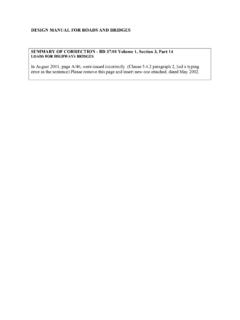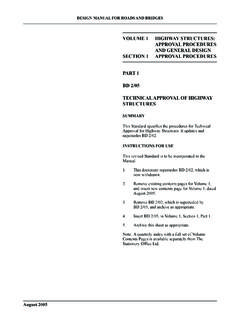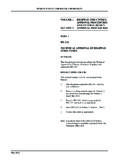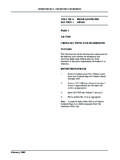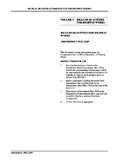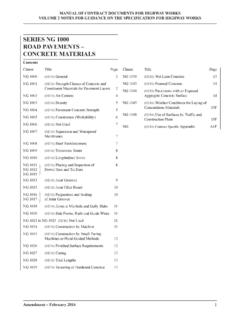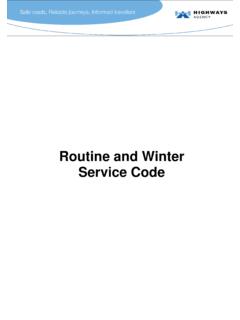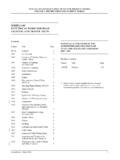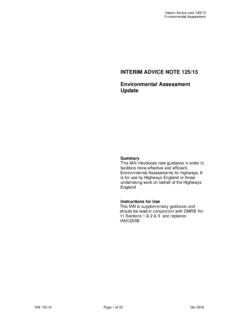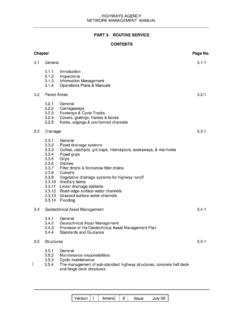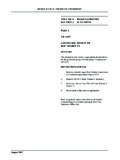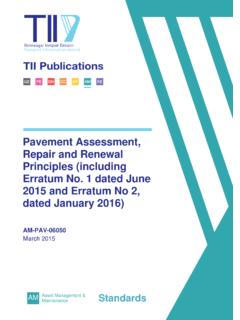Transcription of DMRB VOLUME 6 SECTION 2 PART 3 - TD 50/04 - …
1 November 2004 DESIGN MANUAL FOR ROADS AND BRIDGESVOLUME 6 ROAD GEOMETRYSECTION 2 JUNCTIONSPART 3TD 50/04 THE GEOMETRIC LAYOUT OF SIGNAL-CONTROLLED JUNCTIONS ANDSIGNALISED ROUNDABOUTSSUMMARYThis document sets out the design standards,methodology and good design practice for thegeometric layout of signal-controlled junctions andsignalised roundabouts for trunk roads. Measures toensure safe operation for all road users are 50/04 supersedes TD 50 FOR USEThis Standard now contains expanded advice atparagraph for Junction Intervisibility Zones forjunctions with Advance Stop-Lines for existing contents page for VOLUME 6 andinsert new contents pages for VOLUME 6 datedNovember TD 50/99 from VOLUME 6, SECTION andarchive as TD 50/04 into VOLUME 6, SECTION 2, part archive this sheet as : A quarterly index with a full set of VolumeContents Pages is available separately from TheStationery Office Ltd.
2 TD 50/04 The Geometric Layout of Signal-Controlled Junctions andSignalised RoundaboutsSummary:This document sets out the design standards, methodology and good designpractice for the geometric layout of signal-controlled junctions and signalisedroundabouts for trunk roads. Measures to ensure safe operation for all roadusers are described. TD 50/04 supersedes TD 50 MANUAL FOR ROADS AND BRIDGESTHE HIGHWAYS AGENCYSCOTTISH EXECUTIVEWELSH ASSEMBLY GOVERNMENTLLYWODRAETH CYNULLIAD CYMRUTHE DEPARTMENT FOR REGIONAL DEVELOPMENTNORTHERN IRELANDV olume 6 SECTION 2 part 3 TD 50/04 November 2004 REGISTRATION OF AMENDMENTSA mendPage NoSignature & Date ofAmendPage NoSignature & Date ofNoincorporation ofNoincorporation ofamendmentsamendmentsRegistration of AmendmentsVolume 6 SECTION 2 part 3 TD 50/04 November 2004 REGISTRATION OF AMENDMENTSA mendPage NoSignature & Date ofAmendPage NoSignature & Date ofNoincorporation ofNoincorporation ofamendmentsamendmentsRegistration of AmendmentsVOLUME 6 ROAD GEOMETRYSECTION 2 JUNCTIONSPART 3TD 50/04 THE GEOMETRIC LAYOUT OF SIGNAL-CONTROLLED JUNCTIONS ANDSIGNALISED Design Users Specific Arrangements and 1 Terms and
3 Definitions used in SignalControlDESIGN MANUAL FOR ROADS AND BRIDGESN ovember 2004 VOLUME 6 SECTION 2 part 3 TD 50/04 November 20041/1 Chapter 1 Introduction1. standard identifies those aspects of signalcontrol which have an effect on geometric layoutdesign, and which should be considered throughout thedesign process. Advice on the method of installation,control and signal display sequences are containedwithin Design for Manual Roads and Bridges, VOLUME 8, SECTION 1 (ie dmrb ). Closeco-operation is necessary where a different engineeringteam or discipline is responsible for separate aspects ofdesign, eg geometry, signal control and street is particularly relevant in the early stages ofdesign. To assist this process, terms and definitionsmore frequently used in signal control are provided inAnnex document sets out standards, methodologyand good practice for the design of geometric layoutsfor signal-controlled junctions and signalisedroundabouts where the 85th percentile speed on theapproach roads are below 104kph (65mph).
4 Trafficsignals are not recommended where this approach speedis exceeded [See TA 12 ( dmrb )]. standard shall apply to all newjunctions which are signal-controlled, signalisedroundabouts and to all existing uncontrolledpriority junctions which are modified or improvedto operate with signal Transport Notes (LTN) identified in theDepartment for Transport (DfT) publication listreview the techniques available and recommend factorsto be considered when introducing traffic signal controlat roundabouts. The geometric layout of signalisedroundabouts should be designed in accordance withTD 16 ( dmrb ), however additional geometricdesign guidance on the application of traffic signals toroundabouts is provided in Chapter 6 of this Signal-Controlled Junctions and JunctionsConverted to Signal existing signal-controlled junctions thisstandard should be considered as advice which iscommended to designers when assessing possiblealterations or improvements to the performance of signal control is being installed as a safetymeasure at an existing priority junction withsub-standard junction visibility or where existingsignal-controlled junctions are being modified orimproved, constraints are often imposed upon thedesign by the existing road geometry, buildings,availability of land or the cost of moving statutoryundertakers apparatus.
5 Under these conditions, designstandards contained in this document should beincorporated where possible to improve the overallsafety for all road users and the junction design andsignalling arrangements should be developed tomaximise the junction intervisibility. The procedure forapproval of non-compliant elements of design isoutlined in Paragraph (Departures fromStandard). geometric layout indicated in Figure 1/1 isintended to illustrate a situation where the physicalconstraints imposed by buildings (and statutoryundertakers equipment) may affect the overallgeometric signal control at a junction, includingmeasures to provide the maximum degree of safety andconvenience for all road users, can enhance efficiencyby reducing congestion and conflict between differentvehicle movements, within the available road use of signal control should therefore beconsidered as an option at the scheme assessment stagefor new junctions and the improvement of existingjunctions.
6 Guidance on the selection of the mostappropriate junction option is given in TA 30 ( ). control may also be used in associationwith (or to implement) other strategies such or altering a natural or designatedroute priority; a safe, convenient environment forpedestrians and cyclists; priority to buses and coaches; traffic control; rapid transit systems (see HM RailwayInspectorate Technical Note (RTN 4)). VOLUME 6 SECTION 2 part 3 TD 50/04 November 20041/2 Chapter This Standard shall be used forthwith on allschemes for the construction, improvement andmaintenance of trunk roads currently beingprepared provided that, in the opinion of theOverseeing Organisation, this will not result insignificant additional expense or delay Organisations should confirm itsapplication to particular schemes with theOverseeing It is important to identify the full requirements ofthe scheme at the preliminary design stage, beforeacquiring land (eg if pedestrian crossing routes are notidentified it could be difficult to include them laterwithout either obtaining additional land orcompromising the layout).
7 Design of a signal-controlled junction is aniterative process involving the assessment of trafficperformance of draft layouts followed by appropriatemodifications to the geometric layout to finally obtainthe optimum solution. There is a limit to what may beachieved in terms of increased capacity by, for example,widening junctions to provide additional lanes,introducing traffic islands or improving turning radii. Abalance normally needs to be This standard sets out the specific requirementswhich should be met for signal-controlled junctions andsignalised roundabouts on trunk roads where the 85thpercentile speed on the approach to the junction doesnot exceed 104kph (65mph) on any Design features which relate specifically topedestrians, cyclists, equestrians and buses arecontained in Chapter 4 of this 1/1: Example of Existing Signal-Controlled Junction Subject to Design ConstraintsVolume 6 SECTION 2 part 3 TD 50/04 November The geometric features and layout should bedesigned to accommodate the positioning of signallingequipment (including mast-arms where appropriate),pedestrian facilities and equipment, signs, illuminatedbollards, guardrails, and stop lines.
8 It is also necessaryto consider maintenance requirements and use of thejunction under police control when carrying out thegeometric In the various figures, the junction arms arereferenced clockwise (commencing at the major road),so that the order is major-minor-major. Basic primaryand secondary signals, pedestrian signals and pushbuttons are generally indicated in the figures, howeveradvice on the type, aspect and symbol for particularcircumstances is contained in dmrb Other designfeatures and turning restrictions are included toillustrate their application. The inclusion or exclusionof design features is not intended to suggestapplicability to particular junction Sections of this document which form partof the standards which the OverseeingOrganisation requires in design are highlighted bybeing contained in boxes.
9 These are the sectionswith which the Design Organisation must complyor must have agreed a suitable departure fromstandard with the relevant OverseeingOrganisation. The remainder of the documentcontains advice and enlargement which iscommended to designers for their from In those situations where, for reasons ofsignificant environmental impact or high cost, adesigner considers that a mandatory requirement ofthis Standard may be inappropriate, the designorganisation shall apply to the relevant OverseeingOrganisation for approval to adopt a Departurefrom Standard. Design Organisations faced by suchsituations and wishing to consider pursuing thiscourse shall discuss any such option at an earlystage in design with the relevant OverseeingOrganisation. Proposals to adopt Departures fromStandard must be submitted by the DesignOrganisation to the Overseeing Organisation andformal approval received BEFORE incorporationinto a design Goods The term Large Goods Vehicles is used in thisdocument to identify those vehicles (defined as over gross weight) classified as LGV s for licensingpurposes in accordance with European harmonisation 1 IntroductionVolume 6 SECTION 2 part 3 TD 50/04 November 20042/1 Chapter 2 Geometric Design Features2.
10 GEOMETRIC DESIGN chapter outlines the geometric designfeatures to be considered in the design of signal-controlled junctions. Many of the features areconsidered separately, and designers should adopt asystematic approach to achieve a satisfactory designincorporating all appropriate geometric design design standards are dependent on theapproach speed of vehicles and reference should bemade to TD 9 ( dmrb ) to determine appropriatedesign speeds for each entry arm. Where these designspeed related standards cannot be achieved then trafficmanagement measures should be introduced to reducethe approach speed to an appropriate value, for theavailable Stopping Sight Distance (SSD). 22 ( dmrb ) provides guidance fordetermining speed limits, and design speeds based uponthe 85th percentile approach speed of travelling at even moderately high speedson roads where signal control is installed can findthemselves with a difficult decision to make when greenchanges to amber and drivers are often faced with achoice between attempting to brake to a halt at the stop-line, or continuing at the same speed through thejunction and clearing it safely.
